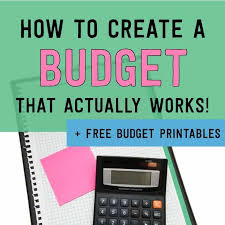How to Create a Budget That Actually Works

Creating a budget is one of the most effective ways to take control of your finances and achieve your financial goals. However, for a budget to work, it needs to be realistic, flexible, and tailored to your specific needs. Here’s a step-by-step guide to creating a budget that you can stick to:
1. Define Your Financial Goals
- Identify short-term, medium-term, and long-term goals.
- Short-term: Save for a vacation or emergency fund.
- Medium-term: Pay off debt or save for a car.
- Long-term: Retirement or buying a home.
Why it works: Clear goals motivate you to stick to your budget.
2. Track Your Income and Expenses
- Write down all sources of income (e.g., salary, freelance work, side hustles).
- Review your bank statements, receipts, and bills to understand your spending habits.
- Categorize expenses: fixed (rent, utilities), variable (groceries, transportation), and discretionary (entertainment, dining out).
Why it works: Knowing where your money goes helps you identify areas to adjust.
3. Use the 50/30/20 Budgeting Rule (Optional)
- Allocate your income as follows:
- 50% Needs: Essentials like housing, utilities, groceries, and transportation.
- 30% Wants: Non-essential items like entertainment, dining out, and hobbies.
- 20% Savings/Debt Repayment: Emergency fund, retirement savings, or paying off debt.
Why it works: This simple framework ensures a balanced approach to spending and saving.
4. Set Spending Limits for Each Category
- Based on your income and spending patterns, allocate specific amounts to each expense category.
- Be realistic; don’t cut essential categories too much.
Why it works: Setting limits prevents overspending while leaving room for priorities.
5. Automate Your Savings and Payments
- Set up automatic transfers to your savings account or retirement fund.
- Automate bill payments to avoid late fees.
Why it works: Automation reduces the temptation to spend and ensures consistency.
6. Plan for Irregular Expenses
- Account for seasonal or irregular expenses like holidays, birthdays, or car maintenance.
- Create a sinking fund: save a small amount each month for these expenses.
Why it works: Planning ahead prevents unexpected costs from derailing your budget.
7. Track Your Progress Weekly or Monthly
- Review your spending to see if you’re staying within your limits.
- Use budgeting apps, spreadsheets, or a notebook to track expenses.
Why it works: Regular check-ins help you stay on course and make adjustments if needed.
8. Adjust as Needed
- Life changes like a new job, a move, or unexpected expenses may require you to revise your budget.
- Be flexible and adapt to your current situation.
Why it works: A rigid budget is harder to stick to; flexibility ensures long-term success.
9. Avoid Common Budgeting Pitfalls
- Overestimating Income: Base your budget on actual take-home pay, not gross income.
- Neglecting Small Purchases: Track even small expenses—they add up over time.
- Ignoring Debt: Prioritize paying down high-interest debt to save money in the long run.
Why it works: Avoiding these pitfalls helps you maintain financial stability.
10. Celebrate Small Wins
- Reward yourself for milestones like sticking to your budget for a month or reaching a savings goal.
- Choose small, budget-friendly rewards (e.g., a favorite snack or a movie night at home).
Why it works: Celebrating progress keeps you motivated to stick to your budget.



